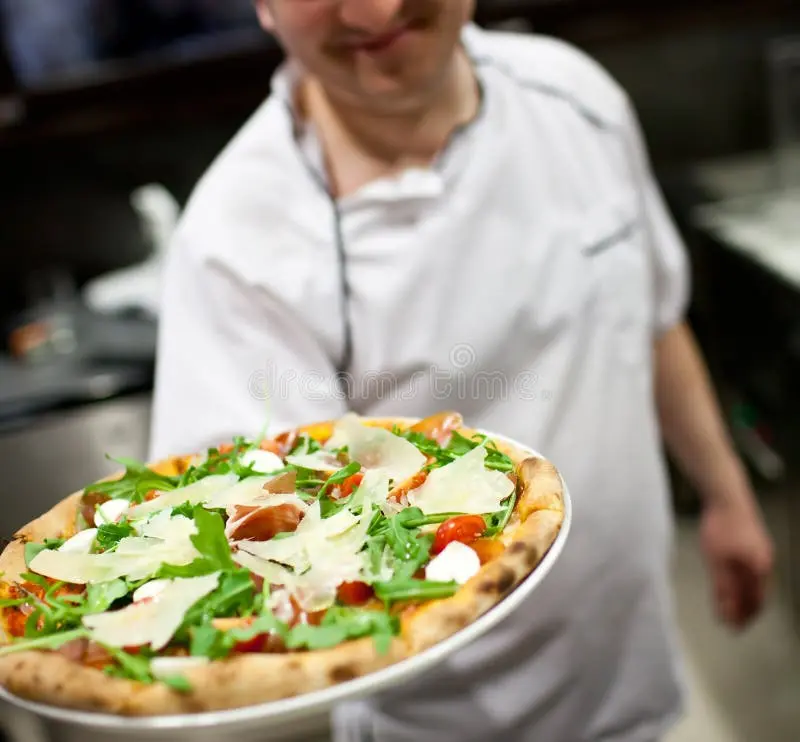Whether you’re at the brink of launching your pizza shop or still weighing the decision, grasping the essentials for kickstarting a thriving pizza business is crucial.
- Deciding on Your Pizza Shop’s Service Style and Brand Identity
Developing a Unique Concept and Brand Identity
Creating a distinctive concept and brand is crucial for visualizing your restaurant, drafting your business plan, and attracting investors.
Selecting Your Pizza Shop’s Service Model
The choice of service style for your pizza shop can significantly influence its operations and customer experience. Below are the most popular service models, with the possibility of integrating elements from multiple styles to suit your vision, budget, and chosen location.
- Sit-down Service: Opting for a sit-down pizzeria can attract a broader clientele by offering a full dining experience, including ambiance and personalized hospitality. This model typically demands a larger initial investment due to the need for more space and staff.
- Delivery Service: Offering delivery appeals to the convenience sought by many customers, though it introduces additional considerations such as the safety of delivery personnel and higher costs to customers to cover delivery services.
- Take-Out Service: Starting a take-out only establishment can be the most cost-effective model, requiring minimal space, equipment, and no table service. The main challenge here is that the appeal of your business will rely heavily on the quality and pricing of your pizza rather than the dining environment or service experience.
- Take-Out Service: Starting a take-out only establishment can be the most cost-effective model, requiring minimal space, equipment, and no table service. The main challenge here is that the appeal of your business will rely heavily on the quality and pricing of your pizza rather than the dining environment or service experience.
Your service style decision will be influenced by your startup capital, location, and the unique ambiance or experience you wish to offer your customers.
- The Business Plan
The initial step towards launching your pizza shop venture involves crafting a comprehensive business plan. This document is crucial for the inception of a bakery, detailing your vision for the pizzeria’s type, its organizational framework, the array of products on offer, approaches to marketing, and anticipated financial outcomes. A pizza shop business plan typically encompasses seven key components:
- Executive Summary
- Overview and Description of the Company
- Analysis of the Market
- Product Offerings
- Management Structure and Ownership
- Marketing and Promotion Strategies
- Financial Forecasts
This plan not only establishes the groundwork for your enterprise but also plays a pivotal role in securing financial backing. A well-constructed business plan is instrumental in navigating the early stages of setting up your pizza palace, ensuring you are well-prepared for the challenges ahead.
- Securing an Ideal Location for Your Pizzeria
Selecting the right location is a critical step in launching your pizza shop. Employ the following strategies to ensure you choose a spot that maximizes your pizzeria’s potential:
- Seek Areas with Limited Direct Competition: Aim to establish your pizzeria in a locale with few similar dining options. While a degree of competition is beneficial for business, being in close proximity to a highly popular pizza outlet might diminish your visibility and impact your customer base.
- Opt for High Visibility: Prioritize locations that guarantee high visibility. This could mean a site along a busy street, areas with significant pedestrian traffic, or places with ample parking. An easily noticeable and accessible pizzeria is more likely to attract walk-in customers and encourage spontaneous dining decisions.
- Research Local Demographics and Dining Habits: Conduct a thorough analysis of the local population, including demographics and dining preferences. Ensure that the community’s characteristics align with the type of service and brand identity you plan to offer. Understanding the local market helps in tailoring your offerings to meet the needs and desires of potential customers, thereby increasing your pizzeria’s appeal and success.
- Securing Financing for Your Pizza Shop
To ensure the financial foundation of your pizza shop is solid, it’s crucial to accurately determine the total startup capital required. This process involves a comprehensive assessment of available personal funds that can be allocated as initial investment and identifying the additional amount needed to launch and sustain your business.
- Compile a List of Startup Expenses: Detail all costs associated with opening your pizza shop. This includes, but is not limited to, leasing or purchasing a location, renovation and decoration, kitchen equipment, initial inventory, permits and licenses, marketing, and any other initial operational costs.
- Estimate Ongoing Operational Costs: Calculate the recurring expenses necessary to keep your pizza shop running. These expenses encompass rent, utilities, salaries, ingredients, and other day-to-day expenses.
- Develop a Financial Forecast: Create a budget that outlines your expected revenue and expenses for at least the first year. This forecast will help you understand the financial performance and cash flow needs of your pizza shop.
- Explore Funding Options: If your available funds are insufficient to cover the startup and operational costs, consider seeking external financing. Restaurant startup loans can be a viable option. Other potential sources of funding include:
- Small Business Loans: Offered by banks and credit unions, these loans can provide substantial capital with relatively favorable terms.
- If you need we know a few
- Restaurant-Specific Loans: Some financial institutions offer loans tailored for the restaurant industry, which may come with terms and conditions better suited to your business model.
- Investors: You might attract private investors interested in the restaurant sector. This could include angel investors or venture capitalists looking for new opportunities.
When preparing to apply for loans or pitch to investors, having a detailed business plan that includes your financial forecasts, marketing strategy, and unique selling proposition will be indispensable. This document not only demonstrates the viability of your pizza shop but also your commitment and professionalism to potential financiers.
- Equipping Your Pizza Shop with the Right Tools
- and not only
To bring your pizza shop concept to life, investing in the right equipment is essential. While specific needs may vary based on your restaurant’s theme and service style, certain foundational pieces of equipment are universally necessary for any pizzeria:
- Refrigeration Equipment: Essential for keeping ingredients fresh. This includes refrigerators and freezers of appropriate sizes to accommodate your inventory.
- Dough Preparation Tools: Quality dough is the backbone of great pizza, necessitating equipment like dough sheeters, dough presses, and proofing cabinets to ensure consistency and efficiency in dough handling.
- Pizza Ovens: The heart of any pizzeria, the choice of oven significantly impacts the texture and flavor of your pizza. Options include conveyor ovens for high-volume production, impinger ovens that use hot air jets, traditional pizza deck ovens, versatile convection ovens, or the classic brick pizza oven for authentic taste.
- Basic Preparation Supplies: Essential tools such as pizza cutters, cutting boards, serving utensils, and plates are required for efficient operation and serving.
- Serving Supplies: To enhance the dining experience, items like pizza stands for the tables and pizza delivery bags for maintaining temperature during delivery are necessary.
- Recruiting Skilled Staff

The Pizza chef you hire will significantly contribute to the public image of your pizzeria.
- Promoting Your Pizza Shop Effectively
Ensuring that both locals and visitors are aware of your new pizza shop and can easily access information about it is key to building your customer base. Generating buzz around your pizzeria will make people eager to visit. Here are strategies to achieve this:
- Leverage Social Media: Establish accounts on platforms like Facebook and Instagram. Share enticing images of your dishes, snapshots of your team in action, and details about your pizzeria. Prioritize the quality of your photos to captivate your audience.
- Develop a User-Friendly Website: Create a website that reflects your brand’s identity and is straightforward to use. It should contain essential information such as your location, contact details, operating hours, and menu.
- Register on Yelp: By listing your pizzeria on Yelp, you make it easier for potential customers to discover you and provide feedback. This platform can also enhance your establishment’s legitimacy.
- Advertise in Local Media: Placing an advertisement in the local newspaper can raise awareness about your pizzeria, particularly if the pizza market in your area is competitive.
- Implement a Digital Loyalty Program: Introduce a rewards program via an app to attract tech-savvy consumers. This approach can help in building a loyal customer base.
- Build an Email Marketing List: Segment your email list to send tailored content to different customer groups, such as dine-in deals for those who book tables or delivery discounts for online orders. Your emails should convey your brand’s personality and foster a connection with your patrons.
- Introduce Promotions for New Customers: Offer incentives like a complimentary soft drink or a side dish with a pizza purchase to make a great first impression. Such gestures can encourage word-of-mouth recommendations and repeat visits.
- Host a Grand Opening Event: Consider organizing a grand opening celebration or other engaging events like pizza-making classes, live music nights, or themed dinners to draw in crowds and create a memorable experience.
These promotional efforts can significantly contribute to establishing your pizza shop as a go-to destination for delicious pizza and a welcoming atmosphere.
